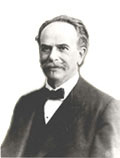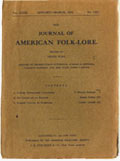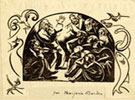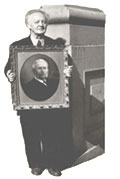|
|
||
Barbeau's StoryThe Folklorist (1)In 1914, I was sent by the Geological Survey to Washington for a meeting of the Anthropological Association. There I was delighted to hear the reputed Dr. Franz Boas of Columbia University. During the meeting, he invited me to lunch. He asked me: "Barbeau, you are a French Canadian, you can tell me a thing we have been wondering about for many years here in the United States. The Indians as far as Mexico have folktales that can be only French in their origin. How did they come to those Indians? Did they come through French Canada? And there are so many French-Canadian coureurs des bois. Could they not have transferred some of their stories to them?" I said, "Dr. Boas, yes I heard some stories at Lorette." "Well," he said, "go back young man, go back to Lorette. It's most urgent that you should collect some of those things." And I did! At Lorette and neighbourhood, and in Charlevoix County, in Kamouraska County, and in Beauce County; folktales were everywhere, overwhelming! And fine folktales! They appealed to me; I liked them. I took them in shorthand, because in the College School in my parish I had learned shorthand, and that came in handy. In Lorette, I may have collected one hundred in the course of a month or two. I'm not sure. Then I began to transcribe them. Then I communicated them to Dr. Franz Boas and he said, "It's exactly what we want. We will publish, if you are willing to prepare it, a number of the Journal of American Folk-Lore (which is usually in English) with those folktales, a whole volume, 150 pages, in French." I sent the folktales down there, and at the next meeting they elected me President of the American Folklore Society. I was President in 1916-17. This was the beginning of recording and publishing more folktales in eight long issues of the Journal of American Folk-Lore down to 1950. I began with folktales at Indian Lorette, but there people told me, "Below here on the coast, Baie-Saint-Paul, at Éboulements, there are people that know plenty of folksongs. They sing whole nights and days." So then this gave me an idea that perhaps I might go there. In 1916 I took my phonograph and blank records and went down to Charlevoix County. After that season, I went back to Ottawa with a collection of over 500 songs which was extraordinary to my own mind, because at that time I was under the impression, like most people, that there were no French-Canadian folksongs that had not been collected by Ernest Gagnon in 1865. But these songs all came one after another as a surprise, and I marvelled at this. I began to transcribe them in black and white and music paper and I thought : "This will be a book!" I got used to transcribing of course. It was hard work in the beginning because I was inexperienced. I knew music, but not in this vein. To listen to other folkloric recordings, please visit the multimedia gallery of the Marius Barbeau Documentation Center. |
Bibliography · Links · Credits · Index





